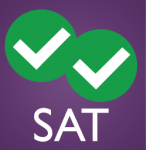 A pervasive and damaging myth among students is that cramming helps. For nearly every scenario, except for that vocabulary quiz in English class which is about to start in 10 minutes, cramming is neither a beneficial nor useful strategy (Even for that English quiz too! You don’t really learn anything). However, more often than not, it is the only available strategy after procrastinating.
A pervasive and damaging myth among students is that cramming helps. For nearly every scenario, except for that vocabulary quiz in English class which is about to start in 10 minutes, cramming is neither a beneficial nor useful strategy (Even for that English quiz too! You don’t really learn anything). However, more often than not, it is the only available strategy after procrastinating.
The SAT is no different. Students who are successful on the test have spent months preparing. They know how to study for the SAT, and their test scores reflect that preparation. One specific technique that these students employ involves breaks. Taking breaks is not only more than okay, but it is also highly, highly recommend. Let me show you why.
Break and Pivot
One useful aspect of breaking is allowing us to switch focus. Long, sustained hours studying the same thing leads nowhere. I am sure you’ve done it. I’ve done it. After a certain amount of time on one topic, I would reach a point where I felt like I was constantly having to bring myself back to my studies. My mind would continuously drift away, and I would have no idea how long I had been turning pages, not consuming the information. I’d turn back the pages, and start again only to have my mind wander off again. So frustrating!
A break is an easy marker to stop and move on to something else. The nice thing about the SAT is that we have a lot of different topics to study so it isn’t hard to pivot to something entirely new. So set a timer for your study period. Focus on the topic for 20-50 minutes, and when the timer goes off, take a break. When you come back from the break, start on a new topic.
The Anatomy of a Break
What does a break look like, though? Is it a nap? A wiki-wormhole that lasts for hours? A break should last for 5-10 minutes. It should involve standing up and moving around, perhaps stepping outside briefly for fresh air and a change of scenery. I would recommend drinking some water and stretching your legs, back, and shoulders. Ultimately, the key is to get oxygen-rich blood flowing through your veins to reinvigorate your mind and body for the next round of learning.
Supports Learning
Breaking from a concept and returning to it later is key to retaining information. For example, let’s say that you are studying SAT vocabulary. Learning new vocabulary requires memorizing words and their definitions. Let’s stop right there. Is memorizing something new a one-day activity? Something done in one study session? No. We all know how easy it is to forget a word and its definition. It is for this reason that we must take breaks.
Spend 20 minutes working on your vocabulary, and move on to something else. Return to the vocabulary the next day, or even in a few days, and study them again. This spaced repetition is a fundamental part of learning something new, and something that scientists have known about since the early 20th century.
Full Day Breaks
A break is not just something you do in a day of studying. Rather, it is an approach that should be used throughout the weeks and months of preparation for the SAT. By allowing your mind time to almost forget a concept, and then return to it, you are building pathways in your brain that become stronger and stronger. The more times you stimulate the pathway, the easier it will be to remember the concept or idea later.
Hermann Ebbinghaus studied memory and is famous for developing the forgetting curve. Basically what it shows is something we intuitively know; after learning something, we begin to forget it. He mapped it out for us. If we never return to the idea, it will be forgotten, but if we use spaced-repetition, and return to the concept, we can ward off the effects of time on our memory.
And we don’t have to return to the idea at the same interval either. The more times we return to the idea to refresh our mind, the longer we can wait until the next time we review the concept. So after seeing something new, return to it the next day. Then wait two days before reviewing—then four, then eight, then 12 days, and so on.
Moral: Don’t Cram — Study for Months Before Your Test
Take breaks during your study sessions and take breaks between your study sessions. No one has to study every day to do well on the SAT. The real secret is to start early and study over the course of a few months. This allows for plenty of breaks, plenty of rest, and plenty of time to learn. Instead of shoveling mounds of knowledge into your cerebral cortex in a short amount of time, add a tablespoon a day and you’ll be more than ready for anything the SAT throws at you.
 This post was written by Kevin Rocci, resident SAT expert at Magoosh. For more advice on SAT prep, check out Magoosh’s SAT blog.
This post was written by Kevin Rocci, resident SAT expert at Magoosh. For more advice on SAT prep, check out Magoosh’s SAT blog.
> For more test prep help, check out NextStepU.com.




Pingback : NextStepU | End the year with great study habits